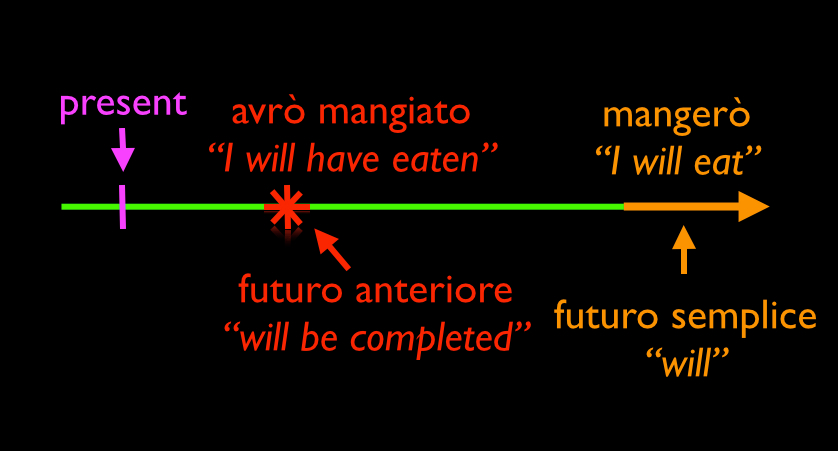The Future tense
- Forming the future tense in Italian
There are two main forms of the future tense in Italian. One is the futuro semplice (simple future) a tense made up of a single verb with a unique stem and endings. The other is the futuro anteriore (future perfect) is a compound tense – meaning it is formed using two verbs. The futuro anteriore refers to actions that will be completed at a point in the future.
Consider the example below which illustrates the difference in quality between the two formations of the future tense:

Forming the future tense in Italian
To learn & practice forming the future tense, watch the following video:
The futuro semplice is created by combining the future stem and the future endings. Here is a table showing how to form the future stems of regular verbs:
Regular future stems
| Model Verb | Stem |
| portare (all -ARE verbs) | porter- |
| scrivere (all -ERE verbs) | scriver- |
| salire (all -IRE verbs) | salir- |
Note how in all conjugations the stem is formed by dropping the final ‑e from the infinitive. However, the first conjugation ‑are infinitives also change the ‑a‑ of the infinitive to an ‑e‑.
The next step is to add the future endings to the future stem to create the future tense.
Future tense endings
| Singular | Plural | ||
| io | -ò | noi | -emo |
| tu | -ai | voi | -ete |
| lui/lei/Lei | -à | loro | -anno |
Adding the future tense endings to the future stems yields the following full conjugation system of the future:
The complete future tense conjugation
| -ARE | -ERE | -IRE* | |
| io | porterò | scriverò | salirò |
| tu | porterai | scriverai | salirai |
| lui/lei/Lei | porterà | scriverà | salirà |
| noi | porteremo | scriveremo | saliremo |
| voi | porterete | scriverete | salirete |
| loro | porteranno | scriveranno | saliranno |
*-IRE verbs in the -ISCO family behave the same as regular -IRE verbs in the future.
ex. porterò i miei genitori alla festa. I'll bring my parents to the party.
Sometimes in conjugating the regular future tense it is necessary to make some changes to the stems in order to conserve the pronunciation of the original verb:
Slightly irregular future stems
| Verb | Stem | Rule | |
| pagare (to pay) | pagher- | -gare » gher- | |
| dimenticare (to forget) | dimenticher- | -care » cher- | |
| cominciare (to begin) | comincer- | -ciare » cer- | |
| mangiare (to eat) | manger- | -giare » ger- | |
| lasciare (to leave) | lascer- | -sciare » scer- | |
| spiare (to spy) | spier- | -iare* » ier- |
*When the -i in the 1st person singular of -IARE verbs (i.e. as is the i in scio), you keep the -i as part of the stem and then conjugate the verb like any other -ARE verb.
As often occurs in Italian the most commonly used verbs are also the most irregular. Here is a table of future stems that are formed irregularly. They are subgrouped according to similar patterns of formation:
Irregular future stems
| Verb | Stem | ||
| essere (to be) | sar- | ||
| -a in -are doesn't change | |||
| dare (to give) | dar- | ||
| fare (to do, make) | far- | ||
| stare (to stay, be) | star- | ||
| dropped infinitive vowel | |||
| andare (to go) | andr- | ||
| avere (to have) | avr- | ||
| cadere (to fall) | cadr- | ||
| dovere (to have to) | dovr- | ||
| potere (to be able to) | potr- | ||
| sapere (to know) | sapr- | ||
| vedere (to see) | vedr- | ||
| vivere (to live) | vivr- | ||
| double r's | |||
| bere (to drink) | berr- | ||
| parere (to seem) | parr- | ||
| rimanere (to stay, remain) | rimarr- | ||
| tenere (to hold) | terr- | ||
| venire (to come) | verr- | ||
| volere (to want) | vorr- |
You can use the following exercises to study the future tense. The first deck addresses the formation of the stems and endings of the future tense:
The second deck contains exercises for practicing the formation of the future in context: